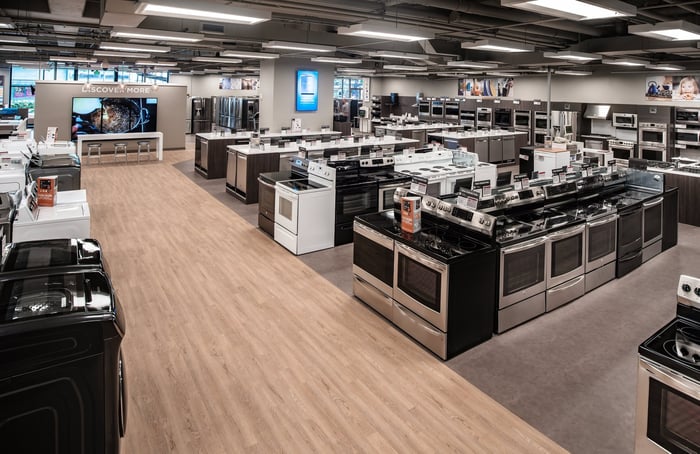For a long time, Sears Holdings (SHLDQ) did little to address its plunging revenue and cash flow other than closing underperforming stores and trying to sign more people up for its Shop Your Way loyalty program. However, in recent years, the retail icon has started to become more creative in its attempts to reinvent itself.
Most notably, Sears has started opening small-format stores that specialize in selling appliances and mattresses. It has also been shrinking some of its full-size stores and devoting most of the remaining floor space to better-performing categories like appliances, tools, and mattresses.

Sears has started to shrink some of its full-size stores. Image source: Sears Holdings.
Sears should have launched these small-format concepts five years ago or more. Unfortunately, they are coming too late to prevent the company's demise.
Heading for oblivion
For years, it seemed like Sears Holdings' management thought that by closing a few more stores and cutting overhead spending, it could stabilize the company's finances.
Instead, free cash flow turned negative soon after the Great Recession and spiraled downward after 2012. For the past few years, Sears Holdings has been burning between $1.5 billion and $2.0 billion of cash every year. The only reason it has survived this long is that it has been able to sell off billions of dollars of real estate and other assets.
Sears Holdings Free Cash Flow (TTM), data by YCharts.
It's clear that the Kmart chain has lost all relevance with consumers. As a result, Sears Holdings has closed nearly half of its Kmart locations just since the beginning of 2016, paring the store count from 941 to 510.
The Sears chain is in slightly better shape, largely thanks to its strength in appliances, tools, and other hardlines merchandise categories. However, a typical Sears store has huge amounts of space devoted to clothing, even though apparel and soft home goods accounted for only a quarter of Sears' revenue last year (roughly speaking). This is clearly a poor use of space.
Sears finally has the right idea
By opening small-format stores and downsizing full-line locations, Sears will be able to exploit its strengths while getting out of the apparel business for the most part.
Sears opened its first small-format concept store in May 2016: a 10,000 square foot high-tech appliances-only location in Colorado. In 2017, it has experimented with slightly larger stores that carry mattresses as well. The first Sears Appliances & Mattresses store, located in Texas, opened in June. Sears opened two more stores in this format last month, in Pennsylvania and Hawaii.

Sears has opened several small-format stores in 2017. Image source: Sears Holdings.
The Hawaii store shows why the small-format approach is so valuable. Sears sold its full-line store at Ala Moana Center in Honolulu back to the mall owner for more than $200 million in 2012. With its new store, Sears can sell products in two of its best categories at the same mall while only paying rent on a small space and carrying dramatically less inventory.
These concept stores represent the most radical version of a streamlined Sears. However, in more than a dozen malls across the country, Sears is taking a smaller step in that direction and shrinking the size of its stores by roughly 50%. Most of these are properties owned by the company's real estate spinoff, Seritage Growth Properties (SRG -0.77%).
By reducing its square footage, Sears won't have to pay as much in rent to Seritage. (Seritage in turn can release the extra space to higher-paying tenants.) Sears will also save on other operating expenses and will require less working capital. In the smaller space, it will be able to focus on its best-performing merchandise categories.
So what?
Smaller stores are likely to be significantly more profitable for Sears than full-line locations. The first two small-format locations have been very successful, according to management.
However, these small successes probably won't matter in light of a looming liquidity crunch at Sears Holdings. Sears is running out of real estate to sell. While it reached an agreement with the Pension Benefit Guaranty Corporation that will allow it to sell 138 more properties next year, the company will have to contribute more than $400 million to its pension plans in return. It also has hundreds of millions of dollars of debt coming due in 2018.
Sears will be hard-pressed to meet these obligations while also keeping inventory on the shelves of its stores. Barring a miraculous recovery in free cash flow next year, Sears could be forced to file for bankruptcy in 2018 or early 2019.
If Sears had moved more aggressively toward small-format stores five years ago, it might have been able to reinvent itself -- even if a bankruptcy restructuring was still necessary. Today, it seems extremely unlikely that Sears will be able to build up a viable network of smaller stores before it runs out of cash. In other words, Sears' small-format concepts will probably be killed by the collapse of its legacy business.






